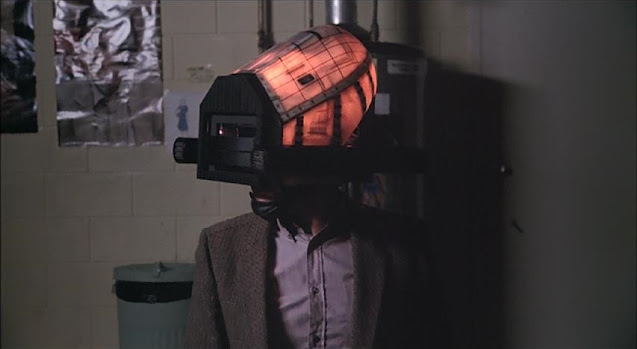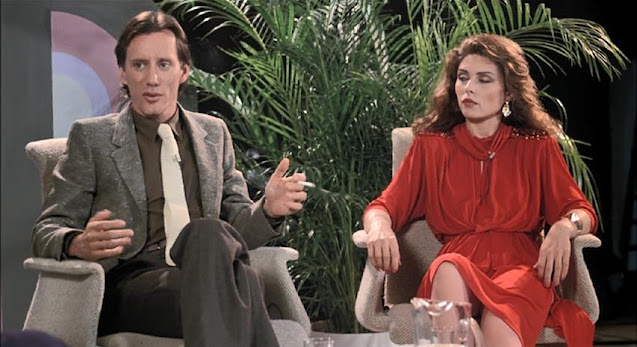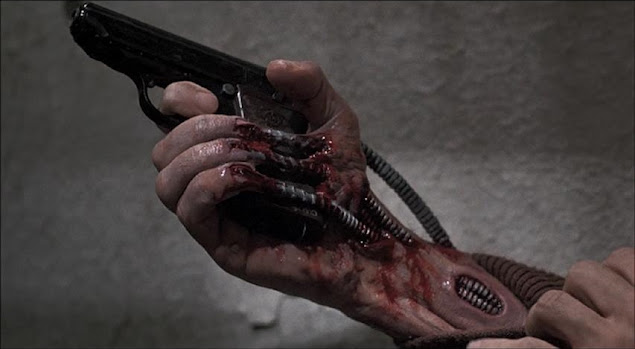(1983) Written and directed by David Cronenberg; Starring: James
Woods, Deborah Harry, Sonja Smits, Peter Dvorsky, Leslie Carlson and Jack
Creley; Available on Blu-ray and DVD
Rating: ****
“…what if the images that you pulled up were really quite
extreme, disturbing, possibly illegal. What would you think then? Would you
keep seeking out those channels, or would you call the police, or what would
you do? How would you respond to that?” – David Cronenberg (from Criterion DVD commentary)
Videodrome opines (with
apologies to Friedrich Nietzsche) that when you gaze at the television, the television
also gazes back at you. Cronenberg’s first big studio film continues with the concepts
he established in previous films: bodily transformation, alienation and dissociation.
To watch one of his films is to be taken on a dark, unsettling ride into the
unknown, with the outcome uncertain. Much like his polarizing earlier works, Videodrome continues to baffle, disturb and
engage audiences and critics.
James Woods stars as Max Renn, president of Channel 83,
Civic TV (modeled after Toronto’s own City TV, which hosted similar fare), a third-rate
cable channel that’s not above showing anything if it brings in viewers. In his
quest for edgier programming* he takes a deep dive into the rabbit hole, stumbling
upon something he should never have seen, a sadomasochistic program known as Videodrome.
Along the way, he meets radio talk show host Nicki Brand** (played by Blondie
lead singer Deborah Harry), who shares his fearless pursuit of new experiences,
and doesn’t mind playing rough. Soon, Nicki, Max and Videodrome become intertwined
and inseparable. Max soon learns that the program contains a signal that
affects the viewer, creating a tumor that propagates elaborate hallucinations.
It has become a weapon that can manipulate people into doing whatever the new
agenda chooses. As Masha (Lynne Gorman), one of his content providers, points
out, “It has something you don’t have, Max. It has a philosophy, and that’s
what makes it dangerous.” As Videodrome supplants Max’s tenuous hold on
reality, it brings him closer to its sinister purpose, embodied by shadowy
corporate head Barry Convex (Leslie Carlson).
* Random Thought: Maybe some enterprising film studies major
should devote a thesis to discussing Weird Al Yankovic’s UHF, in tandem with Videodrome
(hey, hear me out). Both movies deal with the eccentric programmer for a small,
unassuming TV station, and the crazy new shows they adopt.
** Fun fact #1: In his DVD commentary, Cronenberg pointed
out that the main characters’ names were plays on words: Max Renn was named
after a German racing motorcycle, the Rennmax, while Nicki Brand was named
after her sadomasochistic tendencies.
Max’s guide into the brave new video world is Brian
O’Blivion (Jack Creley), an obvious simulacrum for media guru Marshall McLuhan.
O’Blivion refuses to engage anyone face to face, instead preferring to
communicate through a TV screen. Much like the title character in The Wizard of Oz, he presents a public
persona, with the true man hidden underneath. What lies behind the curtain? It’s
a secret guarded by O’Blivion’s daughter Bianca (Sonja Smits), who curates his
legacy and runs the Cathode Ray Mission.* The church serves as a refuge for
derelicts, filled with individual cubicles and televisions. Its ultimate
purpose is never made clear, but it presumably exists as an outlet for O’Blivion’s
teachings, providing a refuge from an uncaring world. TV doesn’t care who you
are, it only demands your unwavering attention.
* Fun Fact #2: According to Cronenberg, the concept for the
Cathode Ray Mission sprung from him speculating, “What would a Salvation Army
created by Marshall McLuhan be like?”
Cronenberg cited Marshall McLuhan as one of the primary influences
for Videodrome. McLuhan (along with
Quentin Fiore) stated that: “Television demands participation and involvement
in depth of the whole being. It will not work as a background. It engages you.
Perhaps this is why so many people feel that their identity has been threatened”
(from The Medium is the Massage, by
Marshall McLuhan and Quentin Fiore). This new interactivity comes at a price, raising
issues of privacy and paranoia.* McLuhan also asserted we are unable to grasp
the big picture without understanding how the electronic medium has shaped
human communication. As an extension of this new consciousness, “The New Flesh”
is an electronic self. It lives on in a virtual world free of bodily
constraints. As new video technology (and by extension the internet) evolves
into something more immersive, we have grown so detached from reality that
electronic entertainment has become the new reality. Who we are in real life is
less important than the digital counterpart we have created for ourselves.
* Fun Fact #3: The director made an unintentional cameo in
the film, standing in for Woods, who was afraid to wear the helmet due to his increasing
paranoia on the set. Whether the paranoia was a product of his method acting or
being affected by the subject matter is up for debate.
The effects work by Rick Baker and Steve Johnson merits special
mention, depicting flesh turned mechanical or mechanical devices made flesh.
One of the film’s centerpieces is a big “TeleRanger” console TV, which appears
to come alive when Max pops in a videocassette with the Videodrome programming.
In one scene, the television screen expands, masterfully achieving with practical
effects what would now be accomplished with computer imagery. Likewise, a breathing
videocassette* takes on organic properties. In one of the more unsettling effects, Renn develops
a vaginal opening in his stomach, becoming a direct interface with the Videodrome
cassette.
* Fun Fact #4: Cronenberg chose Betamax cassettes for the
Videodrome programming over VHS, because he preferred the smaller size, and
found them easier to work with.
Cronenberg denied that he was being prophetic when he thought
of the twisted world of Videodrome. It’s
hard, however, to overlook the many parallels to the internet and the pervasive
influence of social media, which can take us to unsavory, even dangerous places
in a hurry (i.e., the “Dark Web”). You can be anyone, immersed in an online
world that’s more real and inviting than the real world itself. Videodrome reminds us that video is
anything but a passive medium (Cronenberg reinforces this point in a scene in
which a gun points out of a TV screen). Its alienating vision has become all
too real in the 21st century. The phrase, “Long live the new flesh,”
spoken at the film’s end, is an apt mantra for a new generation.








Wow, Barry!
ReplyDeleteYou must be the first person to make a UHF/Videodrome connection!
Awesome!!!
LOL! I kind of wondered that when I wrote it. Heck, I also wondered if my synapses were firing correctly, but I decided to leave it in anyway. ;)
DeleteI'm glad you did!
Delete